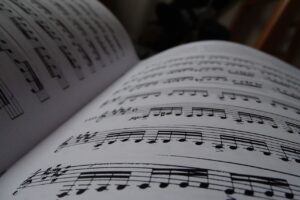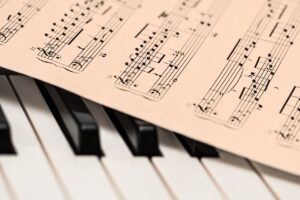Is it possible to learn piano without music theory?
Learning piano without music theory… Undoubtedly a pipe dream for many pianists. Tradition indeed requires spending countless hours working on music theory alongside your instrument, which is undoubtedly very effective. However, this isn’t suitable for everyone, and certainly not for me. Yes, many people view music theory negatively, which discourages them from learning piano, and that’s really unfortunate.
That’s why through this article, I’m going to show you that other solutions exist. If you want to learn piano without music theory, it’s possible, and I’m going to show you how to do it step by step. So, shall we get started?
Why learn piano without music theory?
Learn piano without music theory, what’s the point? Is it a good idea or are you heading straight into a wall? You probably suspect my answer will be nuanced, but I can already tell you that no, you’re not heading into a wall! Let’s start with the advantages of such a learning method.
✅ Key strengths
There are several benefits to learn piano without music theory. Here are the main points to remember :
Learning speed: Unlike long and difficult-to-decipher sheet music, the fact to learn without music theory uses much faster methods. These are numerous, and I’ll discuss them in the next chapter.
Immediate motivation and pleasure: Let’s be honest… Music theory is boring. It’s what discourages a large number of musicians, and that’s understandable! By skipping all that sheet music, you can probably take more pleasure in learning and practicing.
Memory development: Many musicians learning with music theory can no longer detach themselves from their sheet music. Thus, they must constantly have their paper in front of them when they play and are unable to memorize their piece. Learning in another way will allow you to develop your visual and auditory memory to play your piece without any support.
Accessible to everyone: Finally, learn piano without music theory is accessible to anyone. Indeed, the learning methods I’m going to show you are truly accessible and will definitely allow you to get started!
Obviously, there won’t only be advantages to learning piano without music theory, as you might suspect. So let’s look in detail at the weaknesses of this approach.
❌ Potential drawbacks
So what are the disadvantages when it comes to learn piano without music theory? Here are some points to consider.
Less complete information: There’s a good chance that the method chosen to learn piano without music theory will be less comprehensive than sheet music. Indeed, on sheet music, you have the notes, rhythm, dynamics, fingering, intensity, pedaling… Some learning methods don’t have all this information, which might confuse some people.
Difficulty playing in groups or with sheet music: Yes, if you decide to set aside music theory, you’ll inevitably have more trouble playing in groups, like in an orchestra for example. Some rare pieces may also only be available in sheet music form, so you’ll have difficulty learning them, unless you decide to learn them by ear, which is a method I’ll discuss in this article.
As you can see, there will be several advantages and disadvantages to learn piano without music theory. Now that you’re clear on this topic, it’s high time I tell you about the different existing methods!
How to learn piano without music theory?

I was telling you last week about my tips for learning piano self-taught, this time I’m going to give you the ones I use to learn piano without music theory. If you’re allergic to sheet music, don’t worry, I have several solutions for you! It will be up to you to choose the one that suits you best.
Learning by imitation
The first method consists of learning by imitation. To do this, you can follow a video tutorial or an online course (free or paid) and simply reproduce what is being done.
In this style of videos, the person will often give you valuable advice, a rhythm to follow, recommended fingering, how to use the pedal or not, etc… It will be somewhat like an oral sheet music.
This way of learning can be quite lengthy, which is why I don’t recommend it as a default method, but rather as a refinement method when you already master your piece well but need to deepen certain parts.
Learning by ear
Probably the coolest way to learn a piece, but also the most difficult… Depending on your auditory abilities, this exercise will be more or less difficult. But still remember one thing: this method will be very limited and won’t allow you to learn very complex pieces, unless you have exceptional hearing.
Indeed, on long pieces rich in notes (like elaborate pieces by Beethoven, Chopin or Liszt), I wish you good luck trying to transcribe every note and every nuance by ear. That’s why I’ll redirect you to the third method which is in my opinion the best.
Learning with an application
Here’s the method I use most to learn my pieces, using an application! Several applications exist, but personally, I use Synthesia.
This software allows you to visualize notes on a virtual piano in real time. Thus, you only have to remember and reproduce what you see. I personally used this method to play all my pieces, from the simple Letter to Elise by Beethoven to Chopin’s Ballade No.1. By the way, you’ll find right here 10 easiest piano pieces to start with!
Obviously, this isn’t a product placement for Synthesia, you’re not even required to use this software. It’s paid in its latest version, but you might manage to find earlier versions that are free. That’s personally what I did.
And if you don’t want to download software, good news, you can also use YouTube! It will be less easy on YouTube because you won’t be able to adjust the speed and position as easily as on dedicated software, but it works very well too.
Here’s what it looks like. Notes scrolling on the keyboard in real time, somewhat like Guitar Hero. You then just need to reproduce what you see!
Be careful though, as I mentioned earlier, this method, although very effective, lacks any fingering, any rhythm, any dynamics… You therefore need to be comfortable with that to successfully transcribe the music well. Try it and judge for yourself!
Should you learn piano without music theory?

To conclude this short article (no need to make it too long, I prefer to get to the point), I will once again advise you to test all the methods revealed and choose the one that suits you best. And if none of them suit you, you might need to go through the music theory route!
I myself am a fan of software-based learning (I use Synthesia), but I must admit that sometimes I use sheet music to get additional information (fingering used, dynamics, pedal usage). So I can advise you to do like me: learn the basics of music theory to be able to read sheet music and thus use it only when you feel the need.
The piece I shared with you in this article is difficult to master, and yet I learned it with this method. I simply used sheet music when I had difficulties on certain passages. I also looked for specific information on YouTube about learning this piece, particularly on the final part which is bewilderingly difficult.
Learn piano without music theory is therefore possible, provided you go about it with the right methods! So take the time to experiment on your side to choose the best possible solution. And if you haven’t yet found your ideal instrument for learning, discover my article that deals with the differences between acoustic piano and digital piano.
I hope my article has helped you better understand how to learn piano without music theory. Good practice to you!

